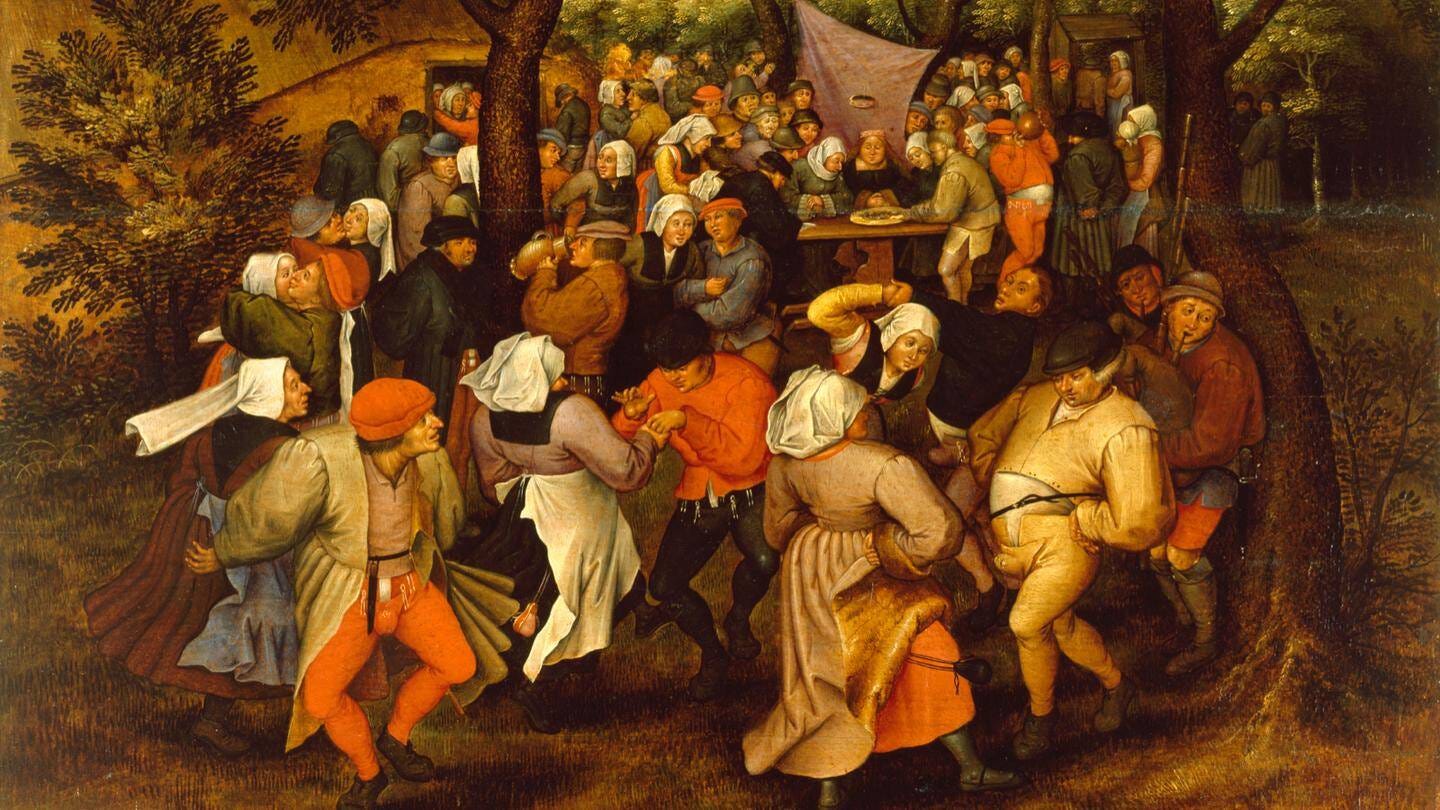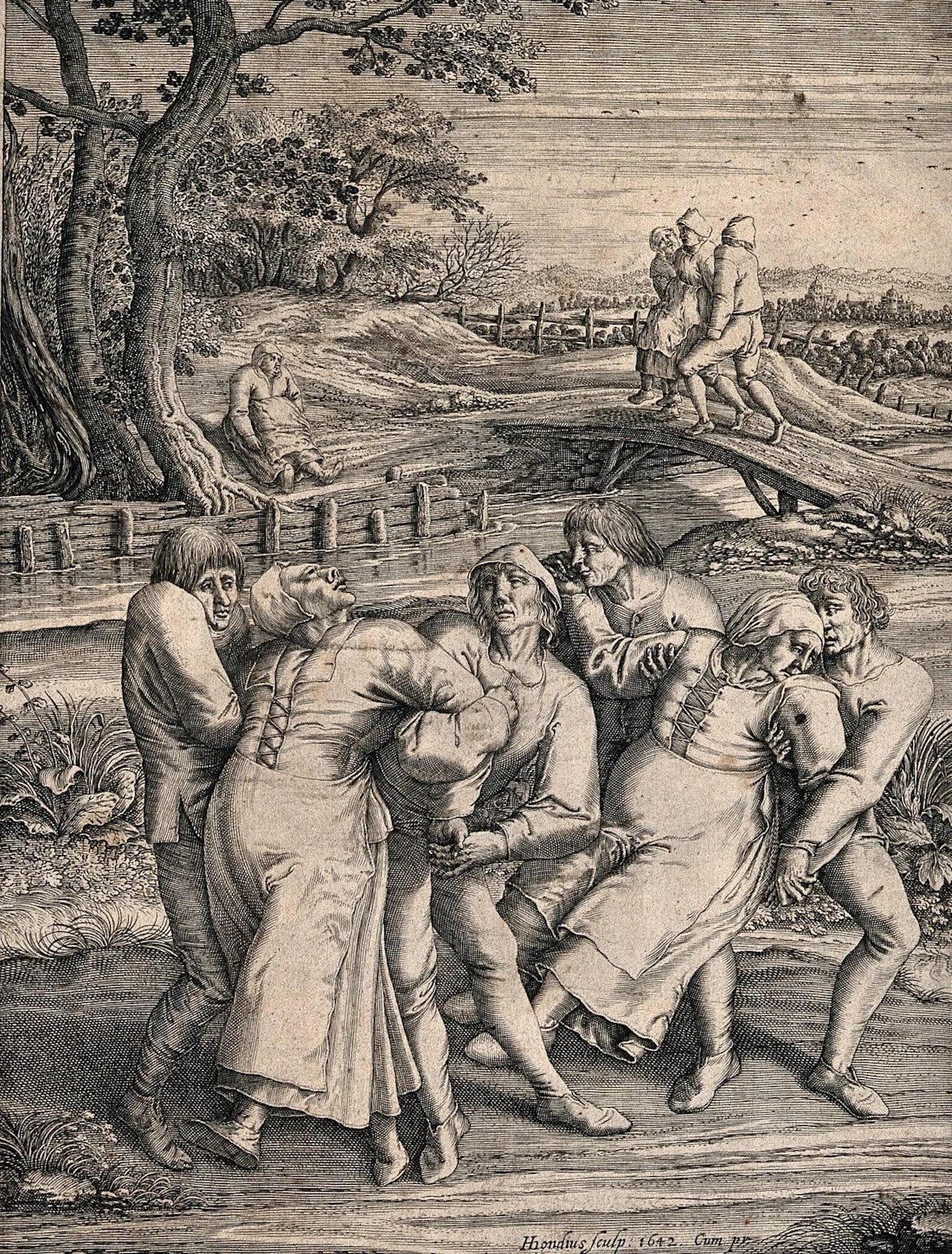St. John’s Dance Mania of 1374
The Dance of Madness
Imagine a quiet medieval town suddenly erupting into chaos, but not with war or plague—with people dancing uncontrollably in the streets, unable to stop, their bodies twisting and leaping as if possessed.
This was the bizarre reality of St. John’s Dance Mania, a phenomenon that swept through Europe in 1374, leaving historians, scientists, and artists puzzled for centuries.
Let’s step into this strange chapter of our history, where the line between body, mind, and spirit blurred in a frenzied dance.
A Frenzy in Aachen
It began in the summer of 1374, in the German city of Aachen, then part of the Holy Roman Empire. Without warning, townsfolk started to dance wildly, uncontrollably, and in large groups. Men, women, and children moved as if compelled by an invisible force, their bodies jerking rhythmically in the streets, marketplaces, and churches. Some shouted, others wept, and many claimed to see visions of saints or demons.
This wasn’t a festival or a celebration. It was something far stranger.
The phenomenon, later dubbed St. John’s Dance (after St. John the Baptist, whose feast day coincided with some outbreaks), wasn’t confined to Aachen. It spread like wildfire across the Rhineland, into modern-day Belgium, the Netherlands, and beyond.
Thousands were caught in its grip, dancing for hours, days, or even weeks until they collapsed from exhaustion, injury, or, in some cases, death.
Contemporary chroniclers described scenes of pandemonium: dancers tearing their clothes, foaming at the mouth, or screaming in pain as their bodies gave out. Some accounts mention people dancing until their feet bled or their hearts failed.
Bystanders were baffled—some believed it was divine punishment, others demonic possession, and a few thought it was a contagious disease of the mind.
What Was St. John’s Dance?
So, what was this strange affliction? To modern eyes, it resembles a mass psychogenic illness, where psychological distress manifests in physical symptoms shared across a group. But in 1374, the world didn’t have the language of psychology. Instead, people turned to religion and superstition to explain it.
One theory held that the dancers were cursed by St. John the Baptist, whose severed head was a potent symbol in medieval Christianity. Some believed they had offended the saint and were now compelled to dance as penance. Others saw it as the work of demons, with exorcisms and prayers deployed to stop the mania. In some towns, priests sprinkled holy water on the dancers or performed rituals to drive out evil spirits.
Yet the response wasn’t always somber.
In a twist that feels almost surreal, some communities tried to cure the dancers by encouraging more dancing.
Musicians were hired to play drums, pipes, and lutes, hoping structured music would guide the frenzied movements into order. It often backfired, drawing more people into the dance. In other cases, authorities banned music and dancing altogether, fearing it would worsen the outbreak.
A Perfect Storm of Causes
Why did this happen in 1374? The answer lies in the turbulent world of 14th-century Europe.
The Black Death, which killed up to half of Europe’s population between 1347 and 1351, had left deep scars. Survivors faced famine, economic collapse, and social upheaval.
The Church, a pillar of medieval life, was fracturing under the weight of the Avignon Papacy and growing skepticism about its authority. Fear and uncertainty were the air people breathed.
This backdrop of stress likely primed communities for collective breakdowns. Mass psychogenic illnesses often arise in tightly knit groups under extreme pressure—think of modern examples like fainting spells at concerts or panic-driven stampedes.
In 1374, the triggers were plentiful: crop failures, religious fervor, and the lingering trauma of plague. Some historians suggest ergot poisoning, caused by a fungus in rye bread, may have played a role. Ergot contains chemicals similar to LSD, which could induce hallucinations and convulsions. But this theory doesn’t fully explain the scale or spread of the mania.
Another factor was the cultural power of dance itself.
In medieval Europe, dance wasn’t just recreation—it was a spiritual and communal act, often tied to rituals or religious festivals.
The line between sacred and profane was thin, and frenzied dancing could be seen as a way to commune with the divine or expel inner turmoil. Add to this the medieval belief in miasma (bad air) or celestial influences like comets, and you have a society ready to interpret a strange outbreak as supernatural.
Cultural Canvas is a reader-supported publication. Every like, comment, share, and donation helps us grow—your support truly matters!
Echoes Across Time
St. John’s Dance wasn’t a one-off. Similar outbreaks, often called choreomania or dancing plagues, occurred across Europe for centuries. The most famous was in Strasbourg in 1518, where a woman named Frau Troffea began dancing and sparked a months-long epidemic.
These events share a haunting similarity: groups of people, often in distress, caught in a shared, uncontrollable act that defied explanation.
Art and literature have long grappled with this phenomenon.
Pieter Bruegel the Elder’s 16th-century paintings, with their vivid depictions of peasant life, capture the chaotic energy of communal rituals gone awry. Later, writers like Edgar Allan Poe and filmmakers like Ingmar Bergman drew on the imagery of frenzied crowds to explore human irrationality.
Even today, the dancing mania resonates in our fascination with collective behavior—think of viral TikTok dance challenges or the crowd dynamics at music festivals.
What It Tells Us
St. John’s Dance Mania is a window into the medieval mind, where the boundaries between body, soul, and society were fluid. It reminds us how deeply our environment shapes our behavior—how fear, faith, and community can combine in unpredictable ways.
In 1374, people didn’t have neuroscience or sociology to explain their actions, so they turned to saints, demons, and stars. Yet their experience isn’t so alien. Modern mass psychogenic events, from panic-buying during crises to viral internet trends, show that we’re still susceptible to collective madness.
It’s a reminder that humans are both fragile and resilient, capable of descending into chaos and emerging with stories that endure.
Missed our last story? Read it here!
Thank you for being part of Cultural Canvas! If you love what we do, consider supporting us to keep it free for everyone. Stay inspired and see you in the next post!







🤔